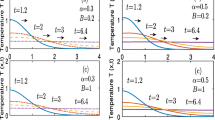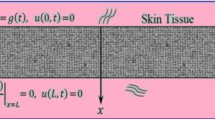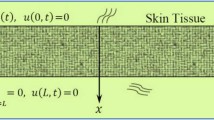Abstract
In this paper, the ultra-short pulsed laser treatment is numerically simulated for a focused laser beam applied to a cylindrical domain. To do so, the general form of the variable-order fractional-order, dual-phase lag bioheat transfer equation is implemented. To determine the major affecting parameters, the dimensionless form of the heat equation is derived and solved numerically. An efficient method based on the 2D Legendre wavelets is developed to provide a numerical solution for this variable-order time fractional model. The man advantage of the proposed algorithm is that it converts the solution of the problem into solution of a system of algebraic equations. The validity of the formulated method is investigated through one numerical example. The effect of several operational and thermo-physical properties including the phase lag time, fractional order, and the duration of active laser beam in each on/off cycle on the thermal field and heat penetration depth is examined. According to the results, it is concluded that by increasing the fractional order from 0.1 to 0.9, 65.1% increase in the penetration length occurs.









Similar content being viewed by others
References
Mao YD, Xu MT (2015) Non-Fourier heat conduction in a thin gold film heated by an ultra-fast-laser. Sci China Technol Sci 58:638–649
Khafaji M, Zamani M, Golizadeh M, Bavi O (2019) Inorganic nanomaterials for chemo/photothermal therapy: a promising horizon on effective cancer treatment. Biophys Rev 11:335–352
Zhang Y, Tzou DY, Chen JK (2009) Micro- and nanoscale heat transfer in femtosecond laser processing of metals. In: Barret P, Palmer M (eds) High-power and femtosecond lasers: properties, materials and applications, 1st edn. Nova Science Publisher, New York, pp 159–206
Niemz M (1996) Laser–tissue interactions. Springer, Berlin
Cui Y, Li YH, Xing YF (2016) One-dimensional thermal analysis of the flexible electronic devices integrated with human skin. Micromachines 7(11):210
Roohi R, Emdad H, Jafarpur K (2019) A comprehensive study and optimization of magnetic nanoparticle drug delivery to cancerous tissues via external magnetic field. J Test Eval 47(2):681–703
Roohi R, Emdad H, Jafarpur K, Mahmoudi M (2020) Determination of magnetic nanoparticles injection characteristics for optimal hyperthermia treatment of an arbitrary cancerous cells distribution. J Test Eval 48(2):905–921
Kumar S, Damor RS, Shukla AK (2018) Numerical study on thermal therapy of triple layer skin tissue using fractional bioheat model. Int J Biomath 11(4):1850052
Ali F, Imtiaz A, Khan I, Sheikh NA (2018) Flow of magnetic particles in blood with isothermal heating: a fractional model for two-phase flow. J Magn Magn Mater 456(15):413–422
Roohi R, Heydari MH, Bavi O, Emdad H (2021) Chebyshev polynomials for generalized Couette flow of fractional Jeffrey nanofluid subjected to several thermochemical effects. Eng Comput 37:579–595
Roohi R, Heydari MH, Aslami M, Mahmoudi MR (2018) A comprehensive numerical study of space-time fractional bioheat equation using fractional-order Legendre functions. Eur Phys J Plus 133:412–427
Cattaneo C (1948) Sulla conduzione de calore. Atti del seminario matematico e fisico dell’universit’ a di modena 3:3–21
Vernotte P (1958) Les paradoxes de la theorie continue de l’equation de la chaleur. Comptes rendus de l’Academie des Sciences 246:3154–3155
Hosseininia M, Heydari MH, Roohi R, Avvazzadeh Z (2019) A computational wavelet method for variable-order fractional model of dual phase lag bioheat equation. J Comput Phys 395:1–18
Ma J, Yang X, Sun Y, Yu J (2019) Theoretical analysis of nanoshell-assisted thermal treatment for subcutaneous tumor. J Mech Behav Biomed Mater 93:70–80
Majchrzak E, Mochnacki B (2018) Dual-phase lag model of thermal processes in a multi-layered microdomain subjected to a strong laser pulse using the implicit scheme of fdm. Int J Therm Sci 133:240–251
Atangana A, Gómez-Aguilar JF (2018) Decolonisation of fractional calculus rules: breaking commutativity and associativity to capture more natural phenomena. Eur Phys J Plus 133:166
Atangana A, Gómez-Aguilar JF (2018) Fractional derivatives with no-index law property: application to chaos and statistics. Chaos Solitons Fractals 114:516–535
Podlubny I (1999) Fractional differential equations. Academic Press, San Diego
Oldham KB, Spanier J (1974) The fractional calculus. Academic Press, New York
Scherer R, Kalla SL, Boyadjiev L, Al-Saqabi B (2008) Numerical treatment of fractional heat equations. Appl Numer Math 58:1212–1223
Langlands TAM, Henry BI (2005) The accuracy and stability of an implicit solution method for the fractional diffusion equation. J Comput Phys 205(2):719–736
Sun HG, Chen W, Wei H, Chen YQ (2011) A comparative study of constant-order and variable-order fractional models in characterizing memory property of systems. Eur Phys J Spec Top 193:185–192
Li XY, Wu BY (2015) A numerical technique for variable fractional functional boundary value problems. Appl Math Lett 43:108–113
Solís-Pérez JE, Gómez-Aguilar JF, Atangana A (2018) Novel numerical method for solving variable-order fractional differential equations with power, exponential and Mittag–Leffler laws. Chaos Solitons Fractals 114:175–185
Heydari MH, Hooshmandasl MR, Mohammadi F (2014) Two-dimensional legendre wavelets for solving time-fractional telegraph equation. Adv Appl Math Mech 6(2):247–260
Heydari MH, Hooshmandasl MR, Maalek Ghaini FM, Cattani C (2015) Wavelets method for the time fractional diffusion-wave equation. Phys Lett A 379:71–76
Heydari MH (2016) Wavelets Galerkin method for the fractional subdiffusion equation. J Comput Nonlinear Dyn 11(6):061014–4
Heydari MH, Avazzadeh Z (2018) Legendre wavelets optimization method for variable-order fractional Poisson equation. Chaos Solitons Fractals 112:180–190
Heydari MH, Avazzadeh Z (2018) A new wavelet method for variable-order fractional optimal control problems. Asian J Control 20(5):1–14
Hosseininia M, Heydari MH, Maalek Ghaini FM, Avazzadeh Z (2019) A wavelet method to solve nonlinear variable-order time fractional 2D Klein–Gordon equation. Comput Math Appl 78(12):3713–3730
Hosseininia M, heydari MH, (2019) Legendre wavelets for the numerical solution of nonlinear variable-order time fractional 2D reaction-diffusion equation involving Mittag-Leffler non-singular kernel. Chaos Solitons Fractals 127:400–407
Shen S, Liu F, Chen J, Turner I, Anh V (2012) Numerical techniques for the variable order time fractional diffusion equation. Appl Math Comput 218:10861–10870
Chen Y, Liu L, Li B, Sun Y (2014) Numerical solution for the variable order linear cable equation with Bernstein polynomials. Appl Math Comput 238:329–341
Hooshmand P, Moradi A, Khezry B (2015) Bioheat transfer analysis of biological tissues induced by laser irradiation. Int J Therm Sci 90:214–223
Waynant R (2002) Laers in medicine. CRC Press LLC, Boca Raton
Canuto C, Hussaini M, Quarteroni A, Zang T (1998) Spectral methods in fluid dynamics. Springer, Berlin
Yin F, Song J, Lu F (2014) A coupled method of Laplace transform and Legendre wavelets for nonlinear Klein–Gordon equations. Math Methods Appl Sci 37:781–791
Hosseininia M, Heydari MH, Maalek Ghaini FM, Avazzadeh Z (2018) Two-dimensional Legendre wavelets for solving variable-order fractional nonlinear advection–diffusion equation with variable coefficients. Int J Nonlinear Sci Numer Simul 19:7–8
Author information
Authors and Affiliations
Corresponding author
Ethics declarations
Conflict of interest
The authors declare that they have no conflict of interest.
Additional information
Publisher's Note
Springer Nature remains neutral with regard to jurisdictional claims in published maps and institutional affiliations.
Rights and permissions
About this article
Cite this article
Roohi, R., Hosseininia, M. & Heydari, M.H. A wavelet approach for the variable-order fractional model of ultra-short pulsed laser therapy. Engineering with Computers 38 (Suppl 3), 2229–2244 (2022). https://doi.org/10.1007/s00366-021-01367-x
Received:
Accepted:
Published:
Issue Date:
DOI: https://doi.org/10.1007/s00366-021-01367-x




